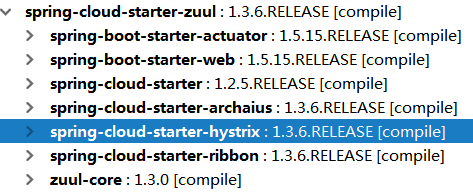【SpringCloud】Zuul在何种情况下使用Hystrix
首先,引入spring-cloud-starter-zuul之后会间接引入:

hystrix依赖已经引入,那么何种情况下使用hystrix呢?
在Zuul的自动配置类ZuulServerAutoConfiguration和ZuulProxyAutoConfiguration中总共会向Spring容器注入3个Zuul的RouteFilter,分别是
-
SimpleHostRoutingFilter
简单路由,通过HttpClient向预定的URL发送请求
生效条件:
RequestContext.getCurrentContext().getRouteHost() != null
&& RequestContext.getCurrentContext().sendZuulResponse()1、RequestContext中的routeHost不为空,routeHost就是URL,即使用URL直连
2、RequestContext中的sendZuulResponse为true,即是否将response发送给客户端,默认为true
-
RibbonRoutingFilter
使用Ribbon、Hystrix和可插入的http客户端发送请求
生效条件:
(RequestContext.getRouteHost() == null && RequestContext.get(SERVICE_ID_KEY) != null
&& RequestContext.sendZuulResponse())1、RequestContext中的routeHost为空,即URL为空
2、RequestContext中的serviceId不为空
3、RequestContext中的sendZuulResponse为true,即是否将response发送给客户端,默认为true
-
SendForwardFilter
forward到本地URL
生效条件:
RequestContext.containsKey(FORWARD_TO_KEY)
&& !RequestContext.getBoolean(SEND_FORWARD_FILTER_RAN, false)1、RequestContext中包含FORWARD_TO_KEY,即URL使用 forward: 映射
2、RequestContext中SEND_FORWARD_FILTER_RAN为false,SEND_FORWARD_FILTER_RAN意为“send forward是否运行过了”,在SendForwardFilter#run()时会
ctx.set(SEND_FORWARD_FILTER_RAN, true)
综上所述,在使用serviceId映射的方法路由转发的时候,会使用Ribbon+Hystrix
而哪种路由配置方式是“URL映射”,哪种配置方式又是“serviceId映射”呢?
Zuul有一个前置过滤器PreDecorationFilter用于通过RouteLocator路由定位器决定在何时以何种方式路由转发
RouteLocator是用于通过请求地址匹配到Route路由的,之后PreDecorationFilter再通过Route信息设置RequestContext上下文,决定后续使用哪个RouteFilter做路由转发
所以就引出以下问题:
- 什么是Route
- RouteLocator路由定位器如何根据请求路径匹配路由
- 匹配到路由后,PreDecorationFilter如何设置RequestContext请求上下文
什么是Route
我总共见到两个和Route相关的类
ZuulProperties.ZuulRoute,用于和zuul配置文件关联,保存相关信息
org.springframework.cloud.netflix.zuul.filters.Route, RouteLocator找到的路由信息就是这个类,用于路由转发
public static class ZuulRoute {
private String id; //ZuulRoute的id
private String path; //路由的pattern,如 /foo/**
private String serviceId; //要映射到此路由的服务id
private String url; //要映射到路由的完整物理URL
private boolean stripPrefix = true; //用于确定在转发之前是否应剥离此路由前缀的标志位
private Boolean retryable; //此路由是否可以重试,通常重试需要serviceId和ribbon
private Set<String> sensitiveHeaders = new LinkedHashSet(); //不会传递给下游请求的敏感标头列表
private boolean customSensitiveHeaders = false; //是否自定义了敏感头列表
}
public class Route {
private String id;
private String fullPath;
private String path;
private String location; //可能是 url 或 serviceId
private String prefix;
private Boolean retryable;
private Set<String> sensitiveHeaders = new LinkedHashSet<>();
private boolean customSensitiveHeaders;
}
可以看到org.springframework.cloud.netflix.zuul.filters.Route和ZuulProperties.ZuulRoute基本一致,只是Route用于路由转发定位的属性location根据不同的情况,可能是一个具体的URL,可能是一个serviceId
RouteLocator路由定位器如何根据请求路径匹配路由
Zuul在自动配置加载时注入了2个RouteLocator
- CompositeRouteLocator: 组合的RouteLocator,在
getMatchingRoute()时会依次调用其它的RouteLocator,先找到先返回;CompositeRouteLocator的routeLocators集合中只有DiscoveryClientRouteLocator - DiscoveryClientRouteLocator: 可以将静态的、已配置的路由与来自DiscoveryClient服务发现的路由组合在一起,来自DiscoveryClient的路由优先;SimpleRouteLocator的子类(SimpleRouteLocator 基于加载到
ZuulProperties中的配置定位Route路由信息)
其中CompositeRouteLocator是 @Primary 的,它是组合多个RouteLocator的Locator,其getMatchingRoute()方法会分别调用其它所有RouteLocator的getMatchingRoute()方法,通过请求路径匹配路由信息,只要匹配到了就马上返回
默认CompositeRouteLocator混合路由定位器的routeLocators只有一个DiscoveryClientRouteLocator,故只需分析DiscoveryClientRouteLocator#getMatchingRoute(path)
//----------DiscoveryClientRouteLocator是SimpleRouteLocator子类,其实是调用的SimpleRouteLocator##getMatchingRoute(path)
@Override
public Route getMatchingRoute(final String path) {
return getSimpleMatchingRoute(path);
}
protected Route getSimpleMatchingRoute(final String path) {
if (log.isDebugEnabled()) {
log.debug("Finding route for path: " + path);
}
// routes是保存路由信息的map,如果此时还未加载,调用locateRoutes()
if (this.routes.get() == null) {
this.routes.set(locateRoutes());
}
if (log.isDebugEnabled()) {
log.debug("servletPath=" + this.dispatcherServletPath);
log.debug("zuulServletPath=" + this.zuulServletPath);
log.debug("RequestUtils.isDispatcherServletRequest()="
+ RequestUtils.isDispatcherServletRequest());
log.debug("RequestUtils.isZuulServletRequest()="
+ RequestUtils.isZuulServletRequest());
}
/**
* 下面的方法主要是先对path做微调
* 再根据path到routes中匹配到ZuulRoute
* 最后根据 ZuulRoute 和 adjustedPath 生成 Route
*/
String adjustedPath = adjustPath(path);
ZuulRoute route = getZuulRoute(adjustedPath);
return getRoute(route, adjustedPath);
}
下面我们来看看locateRoutes()是如何加载静态的、已配置的路由与来自DiscoveryClient服务发现的路由的
//----------DiscoveryClientRouteLocator#locateRoutes() 服务发现路由定位器的locateRoutes()
@Override
protected LinkedHashMap<String, ZuulRoute> locateRoutes() {
//保存ZuulRoute的LinkedHashMap
LinkedHashMap<String, ZuulRoute> routesMap = new LinkedHashMap<String, ZuulRoute>();
//调用父类SimpleRouteLocator#locateRoutes()
//加载ZuulProperties中的所有配置文件中的路由信息
routesMap.putAll(super.locateRoutes());
//如果服务发现客户端discovery存在
if (this.discovery != null) {
//将routesMap已经存在的配置文件中的ZuulRoute放入staticServices<serviceId, ZuulRoute>
Map<String, ZuulRoute> staticServices = new LinkedHashMap<String, ZuulRoute>();
for (ZuulRoute route : routesMap.values()) {
String serviceId = route.getServiceId();
//如果serviceId为null,以id作为serviceId,此情况适合 zuul.routes.xxxx=/xxxx/** 的情况
if (serviceId == null) {
serviceId = route.getId();
}
if (serviceId != null) {
staticServices.put(serviceId, route);
}
}
// Add routes for discovery services by default
List<String> services = this.discovery.getServices(); //到注册中心找到所有service
String[] ignored = this.properties.getIgnoredServices()
.toArray(new String[0]);
//遍历services
for (String serviceId : services) {
// Ignore specifically ignored services and those that were manually
// configured
String key = "/" + mapRouteToService(serviceId) + "/**";
//如果注册中心的serviceId在staticServices集合中,并且此路由没有配置URL
//那么,更新路由的location为serviceId
if (staticServices.containsKey(serviceId)
&& staticServices.get(serviceId).getUrl() == null) {
// Explicitly configured with no URL, cannot be ignored
// all static routes are already in routesMap
// Update location using serviceId if location is null
ZuulRoute staticRoute = staticServices.get(serviceId);
if (!StringUtils.hasText(staticRoute.getLocation())) {
staticRoute.setLocation(serviceId);
}
}
//如果注册中心的serviceId不在忽略范围内,且routesMap中还没有包含,添加到routesMap
if (!PatternMatchUtils.simpleMatch(ignored, serviceId)
&& !routesMap.containsKey(key)) {
// Not ignored
routesMap.put(key, new ZuulRoute(key, serviceId));
}
}
}
// 如果routesMap中有 /** 的默认路由配置
if (routesMap.get(DEFAULT_ROUTE) != null) {
ZuulRoute defaultRoute = routesMap.get(DEFAULT_ROUTE);
// Move the defaultServiceId to the end
routesMap.remove(DEFAULT_ROUTE);
routesMap.put(DEFAULT_ROUTE, defaultRoute);
}
//将routesMap中的数据微调后,放到values<String, ZuulRoute>,返回
LinkedHashMap<String, ZuulRoute> values = new LinkedHashMap<>();
for (Entry<String, ZuulRoute> entry : routesMap.entrySet()) {
String path = entry.getKey();
// Prepend with slash if not already present.
if (!path.startsWith("/")) {
path = "/" + path;
}
if (StringUtils.hasText(this.properties.getPrefix())) {
path = this.properties.getPrefix() + path;
if (!path.startsWith("/")) {
path = "/" + path;
}
}
values.put(path, entry.getValue());
}
return values;
}
此方法运行后就已经加载了配置文件中所有路由信息,以及注册中心中的服务路由信息,有的通过URL路由,有的通过serviceId路由
只需根据本次请求的requestURI与 路由的pattern匹配找到对应的路由
匹配到路由后,PreDecorationFilter如何设置RequestContext请求上下文
//----------PreDecorationFilter前置过滤器
@Override
public Object run() {
RequestContext ctx = RequestContext.getCurrentContext();
final String requestURI = this.urlPathHelper.getPathWithinApplication(ctx.getRequest());
Route route = this.routeLocator.getMatchingRoute(requestURI); //找到匹配的路由
//----------------到上面为止是已经分析过的,根据requestURI找到匹配的Route信息
// ==== 匹配到路由信息
if (route != null) {
String location = route.getLocation();
if (location != null) {
ctx.put(REQUEST_URI_KEY, route.getPath());//RequestContext设置 requestURI:路由的pattern路径
ctx.put(PROXY_KEY, route.getId());//RequestContext设置 proxy:路由id
//设置需要忽略的敏感头信息,要么用全局默认的,要么用路由自定义的
if (!route.isCustomSensitiveHeaders()) {
this.proxyRequestHelper
.addIgnoredHeaders(this.properties.getSensitiveHeaders().toArray(new String[0]));
}
else {
this.proxyRequestHelper.addIgnoredHeaders(route.getSensitiveHeaders().toArray(new String[0]));
}
//设置重试信息
if (route.getRetryable() != null) {
ctx.put(RETRYABLE_KEY, route.getRetryable());
}
//如果location是 http/https开头的,RequestContext设置 routeHost:URL
//如果location是 forward:开头的,RequestContext设置 forward信息、routeHost:null
//其它 RequestContext设置 serviceId、routeHost:null、X-Zuul-ServiceId
if (location.startsWith(HTTP_SCHEME+":") || location.startsWith(HTTPS_SCHEME+":")) {
ctx.setRouteHost(getUrl(location));
ctx.addOriginResponseHeader(SERVICE_HEADER, location);
}
else if (location.startsWith(FORWARD_LOCATION_PREFIX)) {
ctx.set(FORWARD_TO_KEY,
StringUtils.cleanPath(location.substring(FORWARD_LOCATION_PREFIX.length()) + route.getPath()));
ctx.setRouteHost(null);
return null;
}
else {
// set serviceId for use in filters.route.RibbonRequest
ctx.set(SERVICE_ID_KEY, location);
ctx.setRouteHost(null);
ctx.addOriginResponseHeader(SERVICE_ID_HEADER, location);
}
//是否添加代理头信息 X-Forwarded-For
if (this.properties.isAddProxyHeaders()) {
addProxyHeaders(ctx, route);
String xforwardedfor = ctx.getRequest().getHeader(X_FORWARDED_FOR_HEADER);
String remoteAddr = ctx.getRequest().getRemoteAddr();
if (xforwardedfor == null) {
xforwardedfor = remoteAddr;
}
else if (!xforwardedfor.contains(remoteAddr)) { // Prevent duplicates
xforwardedfor += ", " + remoteAddr;
}
ctx.addZuulRequestHeader(X_FORWARDED_FOR_HEADER, xforwardedfor);
}
//是否添加Host头信息
if (this.properties.isAddHostHeader()) {
ctx.addZuulRequestHeader(HttpHeaders.HOST, toHostHeader(ctx.getRequest()));
}
}
}
// ==== 没有匹配到路由信息
else {
log.warn("No route found for uri: " + requestURI);
String fallBackUri = requestURI;
String fallbackPrefix = this.dispatcherServletPath; // default fallback
// servlet is
// DispatcherServlet
if (RequestUtils.isZuulServletRequest()) {
// remove the Zuul servletPath from the requestUri
log.debug("zuulServletPath=" + this.properties.getServletPath());
fallBackUri = fallBackUri.replaceFirst(this.properties.getServletPath(), "");
log.debug("Replaced Zuul servlet path:" + fallBackUri);
}
else {
// remove the DispatcherServlet servletPath from the requestUri
log.debug("dispatcherServletPath=" + this.dispatcherServletPath);
fallBackUri = fallBackUri.replaceFirst(this.dispatcherServletPath, "");
log.debug("Replaced DispatcherServlet servlet path:" + fallBackUri);
}
if (!fallBackUri.startsWith("/")) {
fallBackUri = "/" + fallBackUri;
}
String forwardURI = fallbackPrefix + fallBackUri;
forwardURI = forwardURI.replaceAll("//", "/");
ctx.set(FORWARD_TO_KEY, forwardURI);
}
return null;
}
总结:
- 只要引入了spring-cloud-starter-zuul就会间接引入Ribbon、Hystrix
- 路由信息可能是从配置文件中加载的,也可能是通过DiscoveryClient从注册中心加载的
- zuul是通过前置过滤器PreDecorationFilter找到与当前requestURI匹配的路由信息,并在RequestContext中设置相关属性的,后续的Route Filter会根据RequestContext中的这些属性判断如何路由转发
- Route Filter主要使用 SimpleHostRoutingFilter 和 RibbonRoutingFilter
- 当RequestContext请求上下文中存在routeHost,即URL直连信息时,使用SimpleHostRoutingFilter简单Host路由
- 当RequestContext请求上下文中存在serviceId,即服务id时(可能会与注册中心关联获取服务列表,或者读取配置文件中serviceId.ribbon.listOfServers的服务列表),使用RibbonRoutingFilter,会使用Ribbon、Hystrix
作者:Trust_FreeDom - 博客园
博客主页:http://www.cnblogs.com/trust-freedom/
欢迎转载,但请保留作者和本文链接,谢谢!
欢迎在下面的评论区与我交流。


 浙公网安备 33010602011771号
浙公网安备 33010602011771号